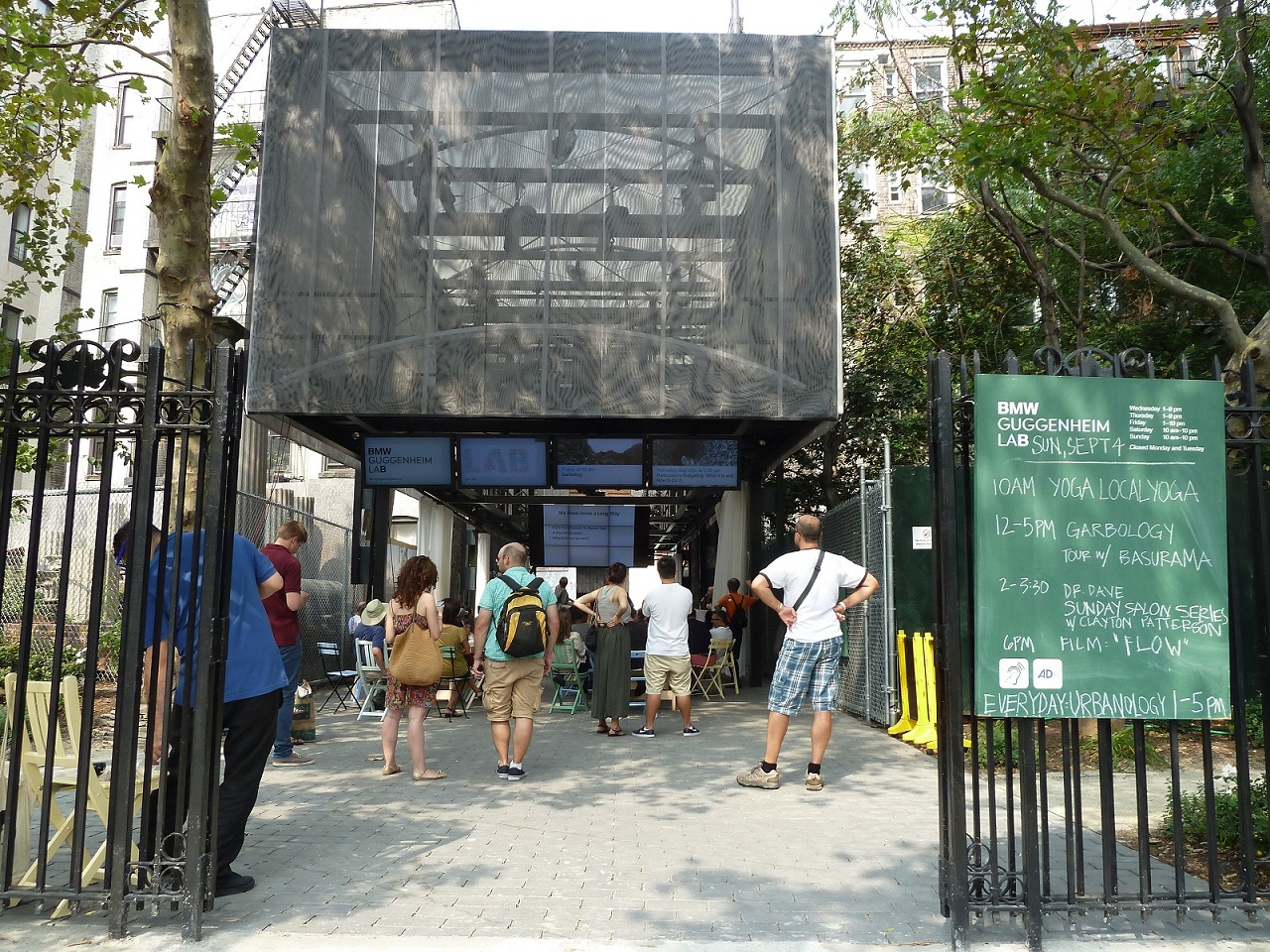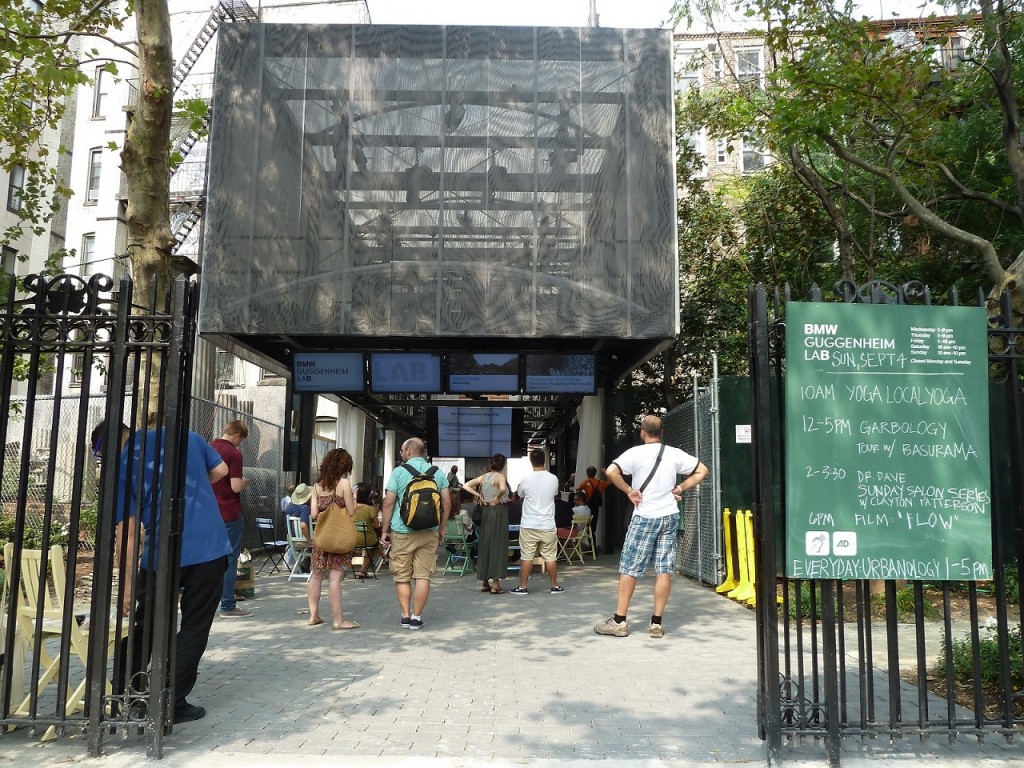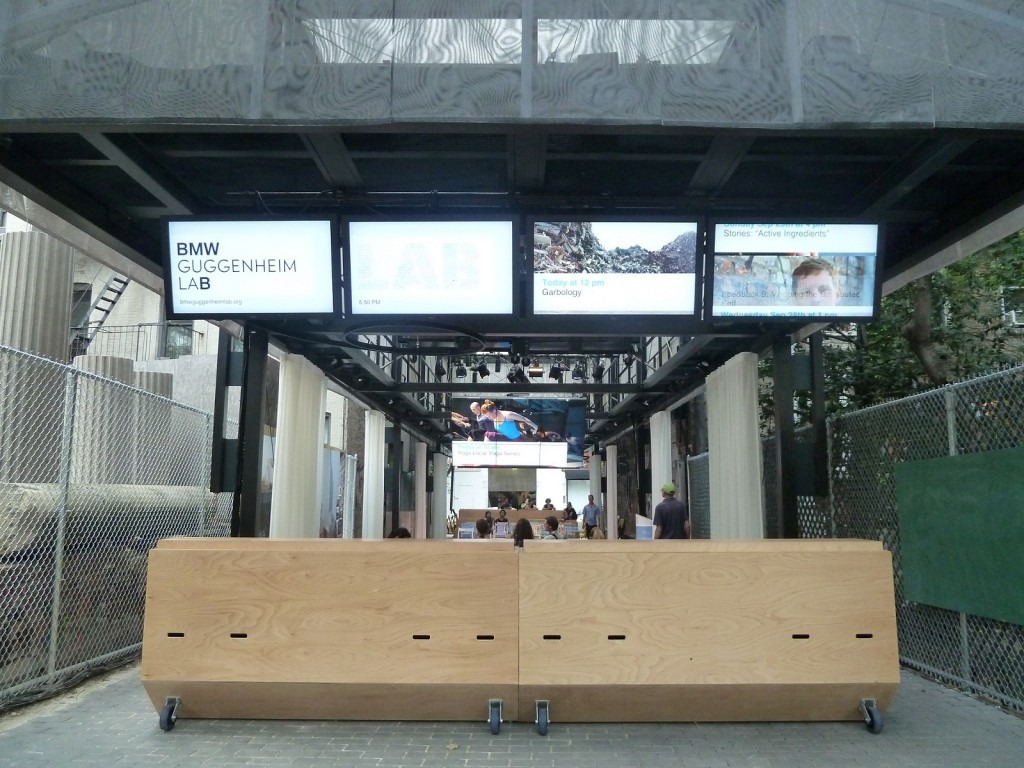Organization: The Guggenheim Museum
Curator: Maria Nicanor and David van der Leer
Website: bmwguggenheimlab.org/
Exhibition: BMW Guggenheim Lab
Dates: August 3 to October 16, 2011
Location: New York
The BMW Guggenheim Lab is a mobile structure that facilitates discussions on addressing the issues of contemporary urban life. The Lab has a holistic purpose. It is for the “exploration of new ideas, experimentation, and ultimately creation of forward thinking solutions for the city”. With the continual migration of people across the globe to urban centers, the Lab’s creation comes to fruition at an opportune time to rethink and reevaluate urban life today.
There will eventually be three distinct labs that operate for two years each in three cities for a total of six years and 9 cities. Each lab will feature unique programming. The theme for Cycle 1 is Confronting Comfort. Once programming finishes in NY on October 16, 2011 the BMW Guggenheim Lab will travel to Berlin and then to Mumbai. Conclusion of Cycle 1 will occur in the Guggenheim Museum in New York in 2013. The BMW Guggenheim lab seeks to “inspire public discourse in cities around the world” The BMW Guggenheim Lab has its own micro website and online communities that help contribute to this dialogue.
The Lab has created a positive neighborhood impact. As a former abandoned lot, site remediation was performed along with contemporary thought and has been transformed into a communal gathering space. Residents in the neighborhood report the successful of the Lab. Local businesses have also witnessed increased patrons and support for their establishments.
The Lab was designed by the Japanese architectural firm Atelier Bow-Wow. The firm is talented in created structures in dense urban contexts. One of the principals, Yoshiharu Tsukamoto, or “Yoshi” as he refers to himself spoke at the Lab on September 8 2011. Yoshi had a warm demeanor and spoke about his design approach and considerations for the Lab. Yoshi was asked to design a “non iconic building” and “public space that was easy to get into”. Yoshi eventually came up with the concept for the lab to be a “theater space” that would allow for the different programming needs, activities, and interactions that would occur in the space. Yoshi then visited theaters to ask for insight. He wanted to understand how to change the scene within the space. Yoshi’s original idea was for the lab to be an “exhibition space”. He concluded with theater space you have scenes, “the scene is totally different and gives a strong animation, it keeps attention and communication”.
A new building material, carbon fiber was used to fabricate the structure, providing a light and open feel to the space. Other notable material is the double mesh fabric that serves as the skin of the structure. It is white inside and black on the exterior. Yoshi states that it is “effected by the wind, always changing” providing a constant change, perhaps metaphorically representing the constant change and reinvention of cities.
Another dominant theme that emerged from his lecture that influences his design is “behavior”. His studio’s work seeks to understand behavior and how design can accommodate it. When refereeing to the Lab, Yoshi says “this space is full of behavior”. Yoshi then expanded on the concept saying that each “behavior has its own time scale. And that now is a time to “bring architecture close to the people”.
The BMW Guggenheim Lab encourages awareness about the built environment and the cities we live in. The Lab also served as the location for the commencement of the Institute For Urban Design for NYC’s first Urban Design Week. By working and supporting organizations that seek to improve city life, the BMW Guggenheim Lab has truly provided a space to engage and support local and global communities.
The BMW Guggenheim Lab is located on 33 East First Street. Rendering and images courtesy of Atelier Bow-Wow.
The Game at the BMW Guggenheim Lab
It is commendable to see people actively and socially participating with the “confront” theme of Cycle 1. The Lab is bringing awareness of the current state, condition, an environmental considerations of New York City.
Sometimes, and it almost happens accidentally at the end of a lecture, a workshop, or event, the Guggenheim members of the Lab being asking people to participate to Urbanology Game. Anyone is invited to answer question from the Lab. This includes architects, urban planners, developers, students, professional, passers-byes, residents, tourists, and others who are simply curious of the unique experience the lab has created. It is a very engaging environment.
The Lab is quite attractive during the Game time at the Lab. On a checkered floor sit five mobile glass towers (corresponding to a -6 to +6 scoring scale) that represent “affordability”, “livability”, “sustainability”, “transportation” and “wealth”: emerging issues of contemporary urban life.
The Game consists of ten challenging questions aimed to stimulate and figure out possible forward-thinking ideas for the future of our cities. Before anyone gives his definite answer, a debate opens among the people playing the game and it can become a rather intense discussion, depending on the nature of the question. Grey areas and indecisiveness about coming up with an answer are forbidden and at the end of the debate, eventually only “yes” or “no” are the only possible responses.
In the end of the game you get a final score that represents the hypothetical city you have built through the ten questions, and the hypothetical city is part of the wider classification that compares the other real cities worldwide.
The Game is a simple and straightforward way to “Confront Comfort”.
The theme for Cycle 1 at the BMW Guggenheim Lab. Through this interactive device people are invited to question / ask themselves about urban themes they may have never thought about, and in the comfort of others they are pushed to make a personal opinion, to agree or disagree, and most importantly to give reasons for their thinking. This makes players – and people – aware that “your city may be the future of our cities.”
Below are some questions from the Game. The game can also be played online on the BMW Guggenheim Lab’s website.
Will you impose an ‘air conditioner’ tax to fund sustainable energy research?
A philanthropist wants to open a free charter school in an underserved inner-city area built on tp of the area’s largest park. Will you allow it?
Will you exempt bookstores from paying property taxes?
Will you raise the minimum wage for people working through the night?
You know the week for a planned attack on City Hall but not the day. It mat kill thousands but closing down for a week is costly. Will you close down?
A major sport franchise is considering a move to the city, but you have to pay for the stadium. Will you do it?
The BMW Guggenheim Lab is located at Houston St at 2nd Ave, New York City.
Co-written by Brunella Angeli and Justin Allen. Published also on SOA (http://www.soaculture.com). SOA Culture is a platform for architects, designers, and artists to share their works within the design and art community. SOA Culture was created and edited by Justin V. Allen. Justin lives in New York City and is a supporter of contemporary Architecture, Design, and Art. Originally from the US, Justin has also lived in Europe and Buenos Aires for two years each, gaining insight of different cultures and its influence on design and art.


